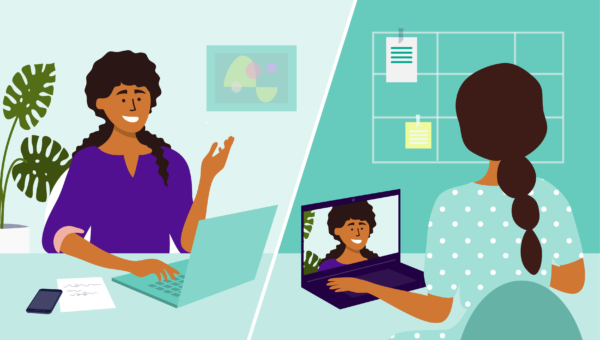A year after beginning NewWave’s fully remote workforce, it’s safe to say the work from home era is here to stay. With some employees already partially remote and meetings mostly online, our transition to a virtual workforce has been successful. But what about the new employees coming on board? How will they be trained? How will they be introduced to the team, and how can we be sure they feel confident in their new roles?
As a training specialist, these were all questions I needed to find answers to quickly. Less than a week after work from home life began, I had two new employees starting and a training program that was not 100% remote – yet.

NewWave supports the Centers for Medicare and Medicaid Services (CMS) Business Operations and Support Center (BOSC) and our BOSC team supports three major programs including the Consolidated Centers for Medicare Modernization and Innovation (CMMI) (CBOSC), the Medicare Enrollment and Payment Systems (MEPS) program, and Okta Identify Management (IDM) (OBOSC).
We had established training for CBOSC and MEPS, however, these employees were joining the new OBOSC team to support a system that hadn’t even launched yet. Not to mention, our training program heavily focused on peer-to-peer shadowing. Something that would not easily be accomplished remotely.
Focusing on help desk best practices and with an understanding of different learning styles, I re-worked the training program I had developed for the new team a few months prior. I pulled concepts from the established BOSC training programs, researched new ways to keep employees engaged remotely, and found alternatives to in-person learning activities.
One year, three successfully trained employees, and a continuously evolving training plan later, I have learned a few key lessons along the way on successfully training new team members in this work from home era.
1. Have your camera on during training sessions. We all know turning on your camera for a zoom meeting is the last thing you want to do, but it’s beneficial! By engaging in eye contact and seeing the speaker, your employees are more likely to stay connected during the training instead of scrolling on their phones. It can also give the trainer a good indicator of when you may need to give a short break or go into more detail on a topic.

2. Schedule one-on-ones between your team members. Gone are the days of bringing new employees around the office and introducing them to the team. You don’t know who is an Iowa State fan, or the person you can count on for Girl Scout cookies. By scheduling one-on-ones with new team members, you can foster a relationship between the new employee and their coworkers. I recommend starting with a 30-minute meeting. It can be very informal in structure. I usually tell team members to have a couple of tips or resources that best helped them when they first started, but also encourage them to just get to know the new employee. I also recommend setting up one-on-ones outside of direct coworkers too. Think technical writers, a manager one level above theirs, or members on related teams.
3. Consider knowledge check-ins. During in-person training, you have visual feedback from participants. They are either nodding, taking notes, or frowning if they do not understand a topic. Training virtually is not convenient for that kind of feedback and your new employee might be too afraid to speak up if they need something explained more. By developing a “test”, which sounds better as a knowledge check, you can gain insight into what topics they are grasping and what areas you may need to revisit. You can even include open-ended questions like, “What area(s) do you feel you could use more training in, or what topics do you feel you understand the best?”
4. Utilize a chat channel. A team chat can be a great way to blend work-related and more casual topics. It gives your new and existing employees space to not only ask quick questions but develop a relationship with the team. It’s more informal than an email and encourages a conversation. Even something as simple as sending a funny good morning GIF can build that connection like the morning gathering around the coffee maker used to.
5. Supplement peer shadowing activities. One of the hardest parts about working from home is the modification to actual training exercises. You can no longer have new employees sit with a team member and shadow them. These activities are still critical in the new employee’s training and you will want to supplement them with a similar activity. In the past, new BOSC help desk employees would spend several days sitting with team members, listening to calls, and eventually working up to taking their own calls while a colleague listened in to provide guidance. A few virtual training program alternatives could include having the new employee listen to previously recorded calls and then practice creating tickets, then letting the new team member compare their practice tickets to the real tickets created by the help desk agent.

None of these tips will fully replace in-person training. However, continuing to evaluate your existing training programs and finding comparable alternatives will help your new employee transition into their role easier, make connections with their team, and ultimately be successful.





